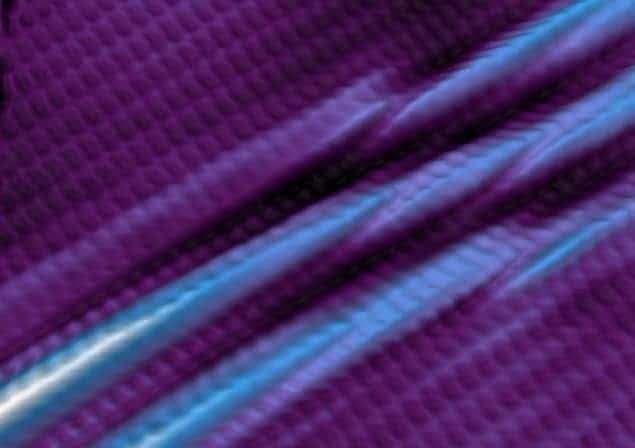
The first boron films that are just one atom thick have been produced by a team of researchers at several institutes in the US. A preliminary study of the ultrathin material called “borophene” suggests that it displays a variety of fascinating and potentially useful properties including direction-dependent conductivity. However, unlike graphene – which comprises a single layer of carbon atoms – the boron films are not free-standing and are instead fixed to a metal substrate.
Since graphene was first isolated in 2004, physicists have been amazed at its extraordinary properties, ranging from extremely high conductance to extremely high mechanical strength. This “wonder material” has also inspired researchers to try to make free-standing, atomically thin films from other materials, and explore their properties.
Boron is one of the most fascinating elements in the periodic table: it is highly reactive, forming very strong and highly delocalized two- and three-centre bonds that are not truly ionic, covalent or metallic. Boron has 16 known bulk-crystal structures (or allotropes), but until recently there was no known 2D form. Predicting what such a structure might look like was difficult because unlike carbon, which forms 2D layers in graphite, boron has no layered allotrope.
Highly unstable
In 2007 Hui Tang and Sohrab Ismail-Beigi at Yale University proposed two possible 2D, free-standing monolayer structures comprising hexagonal bonding networks with periodic vacancies. Then in 2014 Lai-Sheng Wang of Brown University and colleagues discovered a nanoparticle comprising 36 boron atoms that could form a section of one of the sheets (called the α-sheet). However, in the same month, Artem Oganov and colleagues at Stony Brook University concluded that such a sheet would be highly unstable. Further progress was made last year when researchers in China found that a structure just two-atoms thick was produced when a mixture of boron and boron oxide was heated to 1100 °C and passed over a copper substrate.
Now, the Stony Brook team has joined forces with physicists at Argonne National Laboratory and Northwestern University to create and characterize two different – and previously unseen – boron structures that are both just one atom thick. They did this by depositing boron atoms onto a silver substrate at temperatures ranging from 450 to 700 °C. One structure is described as a metastable homogeneous phase and the other as a stable, corrugated “striped” phase. Northwestern’s Andrew Mannix explains that these two new structures are different from ultrathin boron films that have already been created by other teams. This is because previous films have been 2D analogues of 3D phases that are not really new structures.
You can create a whole new world of 2D borons
Artem Oganov, Stony Brook University
The team worked out the atomic structures of the new phases using various analytical techniques such as scanning tunnelling microscopy and electron diffraction. This involved joining forces with the Stony Brook group and using their structural-prediction algorithm to conclude that the stable striped phase should comprise a rectangular, corrugated lattice of boron atoms. This information was then used to calculate what scanning tunnelling micrographs and electron-diffraction data from such a structure would look like. The experimental data were consistent with these calculations, leading the researchers to conclude that their predicted structure is indeed correct.
Stiffer than graphene
By combining its limited experimental data with theory, the team predicts that the structure could have some interesting properties. These include electrical conductivity that depends on the direction of current flow. The material appears to be a metal along the direction of the stripes, whereas it shows evidence of a semiconductor-like band gap for current flowing across the stripes. A similar anisotropy is predicted in mechanical properties, with the material being twice as stiff (and stiffer than graphene) along the stripes as it is across the stripes.
The films studied by the team remained fixed to the silver substrate and a key question is whether or not the monolayer structure can be made free-standing. Oganov is sceptical: “Miracles do happen, and maybe free-standing boron will be one of them, but I have doubts.” He adds: “[Not being free-standing] is a clear disadvantage, but it also brings very clear advantages: graphene is graphene whether you put in on one surface or another surface. But by choosing the appropriate substrate you can tune the electronic state of 2D boron…You can create a whole new world of 2D borons.”
No vacancies
Lai-Sheng Wang is impressed. “I think these are certainly very credible results,” he says. “I don’t really see a weakness.” He adds, however, that “For an isolated monolayer, the most stable structure is with hexagonal vacancies. There is no hexagonal vacancy in these structures but I think that with appropriate conditions that may be formed.”
Indeed, in September 2015 Boris Yakobson and colleagues at Rice University in Texas predicted that a structure containing such vacancies would form on silver. Working independently, Kehui Wu and colleagues at the Institute of Physics in Beijing now claim, in a preprint on arXiv, to have detected Yakobson’s structure experimentally.
The research is published in Science.



